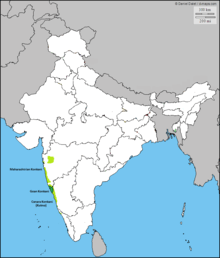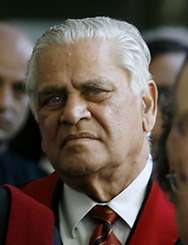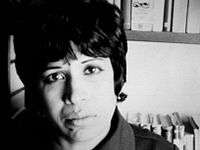Goans
Goans (IPA: [/'gojkaːɾ/]; Goan Konkani: गोंयकार, goykār ?; Romi lipi: Goenkar; Portuguese: Goesas) is the demonym used to describe the people native to Goa, India, who form an ethno-linguistic group resulting from the assimilation of Indo-Aryan, Dravidian, Indo-Portuguese and Austro-Asiatic ethnic and/or linguistic ancestries.[2][3] They speak different dialects of Konkani natively. Goanese is an incorrect usage for Goans.[4]
Goenkar, Goeses or गोंयकार | ||||||||||
|---|---|---|---|---|---|---|---|---|---|---|
| ||||||||||
| (Some notable Goans) Some notable Goans (including those of ancestral descent) | ||||||||||
| Regions with significant populations | ||||||||||
| Goa Maharashtra | 450,000 150,000 | |||||||||
| Languages | ||||||||||
| Primarily: Konkani, Additionally: English, Hindi, Marathi*, Portuguese, Urdu and others | ||||||||||
| Religion | ||||||||||
| Predominantly: Hinduism Minority: Christianity (Roman Catholicism) , Islam and others | ||||||||||
| Related ethnic groups | ||||||||||
| Other Konkani people, East Indians, Mangalorean Catholics, Luso-Indian People | ||||||||||
Epigraphical evidence
A copper plate dating to the early 4th century found in Shiroda, mentions one Devaraja of the Gominas, which is a reference to the Bhoja king ruling from Chandor, who is hailed as the ruler of the Goans or Gominas.[5]
Language

Goans are multilingual, but mainly speak the Konkani language, a Prakrit based language belonging to the Southern group of Indo-Aryan Languages. Various dialects of Konkani spoken by the Goans which include Bardezkari, Saxtti, Pednekari and Antruz. The Konkani spoken by the Catholics is notably different from those of the Hindus, since it has a significant Portuguese influence in its vocabulary. Konkani was suppressed for official use under the Portuguese governance, and therefore played only a minor part in education until annexation by the Republic of India. All Goans were educated in the Portuguese language in the past when Goa was an overseas province of Portugal.[6]
Goans use Devanagari (official) and Latin script (liturgical and historical) for education as well as communication (personal, formal and religious). However the entire liturgy of the Catholic church is solely in the Latin script. In the past Goykanadi, Modi, Kannada and Persian scripts were also used which later fell into disuse owing to many social, political and religious reasons.[7][8]
Portuguese is still spoken by a number of Goans, though it is mainly restricted to upper class Christian families and the older generation.
The Marathi language has played a significant role for Hindus near the northern borders of Goa close to Maharashtra and parts of Novas Conquistas. This is due to the influx of ethnic Marathi people to the area since the late 20th Century.
Religion
Ethnic Goans are predominantly Hindus followed by a large Catholic minority and a small Muslim community. Goan Hindus refer to themselves as Konkane (Devanagari Konkani: कोंकणे), meaning the residents of an area broadly identified as Konkan.[9] Hindus in Goa are divided into many different castes and sub-castes, known as Jatis. They use their village names to identify their clans, some of them use titles. Some are known by the occupation their ancestors have been practising; Nayak, Borkar, Raikar, Keni, Prabhu, Kamat, Lotlikar, Chodankar, Mandrekar, Naik, Bhat, Tari, Gaude are examples.
Catholics are the largest minority constituting about of 26.0% of the total population.[10] Goan Catholics display the highest amounts of Portuguese influence and associations in the form of hierarchy owing to 451 years of close interaction with the Portuguese Empire as an overseas territory.[citation needed] Portuguese surnames are common among the Christians. The Christians have distinct endogamous communities such as Bamonn, Chardó, Gauddo and Sudir that loosely mirror the Hindu Caste hierarchy. Along with Goans, Mangalorean Catholics and East Indian Catholics also had a similar caste systems due to historical ties with Portuguese Goa, but have now become less prominent and impractical due to various reasons including modernity, assimilation& migration to other cities and countries. Some Catholic families also share Indo-Portuguese and count themselves as Luso-Indians or 'mesticos' (which means people of mixed-race) however this constitutes a small minority of the Goan Catholic population. There is a small community of native Muslims in Goa called Moir, the word is derived from the Portuguese Mouro, which means Moor. Muçulmano was the word later used in Portuguese to identify them.[11]
Diaspora
Goans have been migrating all along the coast and across the world for the last six centuries because of socio-religious and economic reasons. The diaspora have been assimilated with the Konkani people, residing in the states of Karnataka, Maharashtra and Kerala, and may not refer to themselves as Goans. Many Goans have settled in Mumbai (Bombay) in the last century and still identify themselves as Goans. Besides Mumbai, India's Goan population is mainly concentrated in the major cities like Bengaluru, Kolkata, Delhi, Chennai and Pune.[12]
Until the early 1970s there were substantial populations of Goans in the Middle East, Africa and Europe. There have also, historically, been Goans in former British colonies of Kenya, Uganda, and Tanzania, and Portuguese colonies of Mozambique and Angola. The end of colonial rule brought a subsequent process of Africanisation and a wave of expulsion of South Asians from Uganda (1972) and Malawi (1974) forced the community to migrate elsewhere, however.[12] The Gulf News put the number of Goans residing outside India as approximately 300,000.[1] Goans across the globe refer to the publication, Goan Voice for news about members from their community.
See also
References
| Look up Goan in Wiktionary, the free dictionary. |
- "Young NRIs trace their roots in Goa". Gulf News. December 8, 2008. Archived from the original on 2009-04-02. Retrieved 2008-12-21.
- Pereira, José (2000). Song of Goa: mandos of yearning. Aryan Books International. pp. 234 pages. ISBN 9788173051661.
- Cabral e Sá, Mário (1997). Wind of fire: the music and musicians of Goa. Promilla & Co. pp. 373 pages(see page 62). ISBN 9788185002194.
- Pinto, Cecil (2003-11-07). "Goanese & non-Goans". Goa Today magazine. Goa Publications. Retrieved 2008-07-04.
- De Souza, Teotonio R. (1990). Goa Through the Ages: An economic history, Volume 2. Concept Publishing Company. p. 8. ISBN 9788170222590.
- "Publications". COSPAR Information Bulletin. 2003 (156): 106. April 2003. doi:10.1016/s0045-8732(03)90031-3. ISSN 0045-8732.
- Indian archives. Volume 34. National Archives of India. National Archives of India. p. 1985.CS1 maint: others (link)
- Kamat, Krishnanand Kamat. "The origin and development of Konkani language". kamat.com. Retrieved 31 August 2011.
- Kulakarṇī, Indian Council of Historical Research, A. Rā (2006). Explorations in the Deccan history Volume 9 of Monograph series. Pragati Publications in association with Indian Council of Historical Research. pp. 217 pages(see page 129). ISBN 9788173071089.
- "Religion". http://censusindia.gov.in/. External link in
|website=(help) - Śiroḍakara, Mandal, Pra. Pā,H. K. ,Anthropological Survey of India. People of India: Goa Volume 21 of People of India, Kumar Suresh Singh Volume 21 of State Series, Kumar Suresh Singh. 1993: Anthropological Survey of India. pp. 283 pages. ISBN 9788171547609.CS1 maint: location (link)
- De Souza, Teotonio R. (1989). Essays in Goan history. Concept Publishing Company. pp. 219 pages(see pages 187–190). ISBN 9788170222637.
.jpg)




